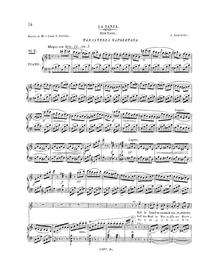La danza (Rossini)

La Danza is a song by the poet and democratic politician of the Italian Risorgimento Carlo Pepoli from 1835. The music was composed by Gioachino Rossini . It is a piece originally composed for solo voice and piano with a quickly sung text to the rhythm of a Neapolitan tarantella . The piece, set in very fast 6/8 time, is an encore at concerts popular with bel canto singers .
history
From 1830 onwards, Rossini was aware that his operas no longer corresponded to the taste of the time, so he switched to sacred music, chamber music and vocal music. La Danza comes from Rossini's song cycle Les soirées musicales , with twelve pieces by various poets from 1830 to 1835, some of which have a folkloric character. The song, originally composed for bassist Luigi Lablache , who successfully sang many opera roles by Rossini, and piano accompaniment, has been edited many times. There are numerous transcriptions of the work, various orchestral versions, also for chamber ensembles, and voices. Franz Liszt produced a virtuoso version for piano solo in 1838 ( Searle catalog no. 424/9), Frédéric Chopin used motifs from La Danza as inspiration for his Tarantella in A flat major, op.43, for piano from 1841, Ottorino Respighi used it in 1918 in his work La boutique fantasque (The Magic Shop), a ballet based on themes by Gioachino Rossini, in an elaborate orchestral version. Like Liszt, the pianist Marc-André Hamelin arranged La Danza for piano solo in an extremely virtuoso manner with modern harmony. The transcription of the piece by the Hungarian pianist György Cziffra , who plays La Danza in a hammering rhythm, using the piano as a percussion instrument, is remarkable . But especially the traditional interpretations of the song by Enrico Caruso , Mario Lanza , Alfredo Kraus , Cecilia Bartoli and many others keep the piece known worldwide even today.
Musical structure
Rossini set the piece in the key of A minor and gave it the performance name Allegro con brio (Italian: quick, lively, cheerful, cheerful, with verve ). The tempo is given with the metronome ![]() = 152, so the dotted quarter note should be played and sung at 152 beats per minute. The 6/8 time runs through the entire piece, which lasts a good three minutes at this tempo. The tenor Enrico Caruso sang the song in 1912 in a studio recording in three minutes and ten seconds, the coloratura - mezzo-soprano Cecilia Bartoli needed for La Danza in a concert of the Victoires de la musique classique , Paris 2003, in stimmakrobatischer, two minutes and 13 Seconds.
= 152, so the dotted quarter note should be played and sung at 152 beats per minute. The 6/8 time runs through the entire piece, which lasts a good three minutes at this tempo. The tenor Enrico Caruso sang the song in 1912 in a studio recording in three minutes and ten seconds, the coloratura - mezzo-soprano Cecilia Bartoli needed for La Danza in a concert of the Victoires de la musique classique , Paris 2003, in stimmakrobatischer, two minutes and 13 Seconds.
After an instrumental introduction of 48 bars, the singing begins: Già - la luna è in mezzo al mare ... In the first stanza it extends over 60 bars to the refrain sung twice in A major in 17 bars: La! - la ra la ra - la ra la la ra la la! This is followed by an instrumental interlude, similar to the introduction, but in eight bars. The second stanza Salta, salta, gira gira ... goes over another 60 bars, then the refrain follows again with 17 bars. The singers usually try this last La! Keep it at full volume for 12 bars of the instrumental aftermath.
text
|
|: Già la luna è in mezzo al mare, |
|: Now the moon is high above the sea, |
Arrangements and transcriptions
Due to its popularity, La Danza exists in numerous instrumentations, arrangements and transcriptions . In addition to Rossini's original piano version with vocals, there are instrumental versions for large orchestras, chamber ensembles, and various solo instruments such as the accordion and guitar . The Ukrainian guitarist Galina Vale delivered an idiosyncratic, virtuoso interpretation for guitar solo in 2009.
Audio sample
( La Danza sung by the Italian tenor Enrico Caruso in a studio recording from 1912)
Web links
- La Danza , version for orchestra and three voices with Juan Diego Flórez , tenor, Vivicagenaux , mezzo-soprano, Nicola Ulivieri , bass and the Orchestra Sinfonica di Milano "Giuseppe Verdi"
- La Danza , sung by the Russian mezzo-soprano Vasilisa Berzhanskaya that in the season 2017/18 as a fellow member of the ensemble of the Deutsche Oper Berlin belongs
Individual evidence
- ↑ Nicole Restle in program booklet No. 81 of the Berliner Philharmoniker ( page no longer available , search in web archives ) Info: The link was automatically marked as defective. Please check the link according to the instructions and then remove this notice.
- ↑ Recording with the National Orchestra of Moldova
- ↑ YouTube recording with a score
- ↑ Historical record recording
- ↑ concert recording
- ↑ Sheet music of Editione Ricordi No. 2413 , Milan 1982, p. 42 ff.
- ↑ YouTube video
- ^ Website of the Deutsche Oper Berlin